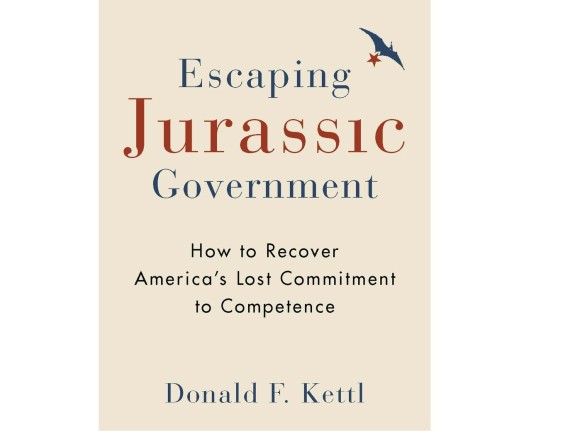America’s Real Crisis: Jurassic Government

This blog was originally published by Statecrafting
The dinosaurs became extinct because they didn’t adapt to a changing environment. There are bad signs that American government is caught in its own Jurassic trap — a mismatch of its structures and processes for the jobs it’s trying to accomplish.
Caught in this trap, we’ve become so preoccupied with policy puzzles — what we should do — that we pay little attention to policy results — how we can get things done. Too many promises go unmet, too many programs get trapped in failure, too many harsh words get spent in blaming opponents for failing citizens. The result? Trust in government is at an historic low, as Americans sense the profound mismatch between promises and results.
This election season has been packed with incivility and gridlock, but the real crisis of the American state is one of capacity. In too many areas, government is falling behind in the quest to build what it needs to get things done.
It’s a problem that’s been bubbling for a long time. In 1933, Luther Gulick concluded that “the government of the part of the world in which we live is in many respects three generations behind our necessities and our social and economic world.” Nearly 30 years later, John F. Kennedy concluded simply that most of the problems we face “are administrative problems.” From the New Deal to the New Frontier and beyond, the gap between what we want our government to do and the capacity of our governmental institutions to deliver has grown and grown.
The New Deal challenged administration because it increasingly relied on new partnerships to deliver public programs. The interweaving of public functions in private institutions has only accelerated since. As I argue in my new book, Escaping Jurassic Government, this problem has now become an existential crisis for the performance of American government. We have lost our commitment to competence.
In the half century before the launch of the New Deal, the Progressive movement built a remarkable bipartisan commitment to a basic principle: whatever government decided to do, it ought to do it well. In fact, it’s hard to remember now that this Progressive commitment to competence was as much the product of Republican as Democratic initiatives, from the creation of the civil service and executive budgeting (both in Republican administrations) to the establishment of the IRS and the Federal Reserve (both in Democratic administrations).
However, in the years since, as John DiIulio has pointed out, Democrats have tended to overreach by passing policies without figuring out how to deliver them. Republicans have campaigned to cut government, gutting capacity without cutting government’s ambition. That’s taken us, by different roads, to the same dysfunctional intersection: a government we don’t believe it, without the administrative capacity to get the job done. It’s little wonder that the public’s trust in government is in a tailspin.
The fundamental problem is this. We have a vertically stove-piped government for an increasingly horizontal world. Much of government works well, especially at the state and local level where government delivers basic goods and services through traditional bureaucracies. There are truly effective parts of the federal government as well, such as the air-traffic control system whose operations are an intricate 24/7 minuet. But much more of government is interwoven, requiring effective collaboration across federal-state-local, public-private-nonprofit, and domestic-global boundaries. The more that government has become interwoven in nongovernmental partners, the more the crisis of capacity has spread.
In fact, the pace of this interweaving has increased much faster than our capacity to manage it. It’s little wonder that government’s performance has so greatly struggled — and our performance problems have occurred happened precisely in those areas where its functions are most interwoven with its non-governmental partners, such as defense contracts, Medicare, Medicaid, and other programs stretching across government’s many boundaries.
Rebuilding trust in our government first requires rebuilding its capacity to produce results. That’s hard but doable, as the government has proven in the remarkable programs to reduce the number of homeless veterans and to shrink crime on Native American reservations. The key lies in building a leveraged government, a government that gets results by building strong partnerships through information systems, to build bridges across the boundaries that otherwise often create unconnected stovepipes.
Rebuilding trust also requires rebuilding a measure of bipartisanship. Hard as it seems now, the first Progressive movement showed it is possible. A century ago, there were fierce battles about what government ought to do, but Republicans and Democrats were united in a commitment that whatever government decided to do, citizens deserved having that done well. A new reform movement — Progressive 2.0 — could take the first steps toward a fresh bipartisan commitment to competence. We can certainly expect we’ll continue to fight over what government ought to do, but we can recognize that restoring trust in government — and escaping a Jurassic fate — begins by ensuring it can deliver on what it promises.
The dinosaurs went extinct because they failed to adapt. The crisis in public trust is a modern-day sign of our government’s own struggle to adapt to its changing environment. We can recognize that government is increasingly interwoven with its nongovernmental partners, that horizontal collaboration is the foundation for an effectively leveraged 21st-century government, and that information systems can build the bridges on which government’s leverage depends. Indeed, in the information age, information can make connections where traditional approaches to hierarchy and authority cannot. That’s the key to helping American government escape the dinosaurs’ fate.